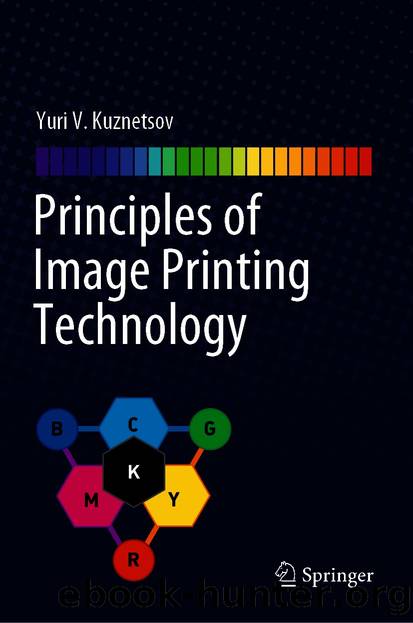Principles of Image Printing Technology by Yuri V. Kuznetsov

Author:Yuri V. Kuznetsov
Language: eng
Format: epub
ISBN: 9783030609559
Publisher: Springer International Publishing
An image-capturing step in which the optical densities of an original are converted into voltages or currents proportional to the luminous flux, and consequently, the reflection coefficient Ï is represented in the fourth quadrant by the characteristic of the PET. This is the dependence of the level number of a linearly quantized signal on the density of an original: NÏâ=âf4 (Dorg).
To go from NÏ signal proportional to the reflections to the signal Nd of more visually uniform optical densities, a logarithmic transformation is used, schematically indicated by curve Ndâ=âf9 (NÏ) of the ninth quadrant.
The sixth quadrant presents the characteristics of the predistortion introduced into the signal to compensate for the dot gain. Curve Ninâ=âf6 (Nd) of this correction accounts for the difference between dot areas on a print and transparency for given prepress and printing processes.
Following now from the ordinate axis of the first quadrant to the left, and further along the scheme, remember that the print density is related to the area S of its halftone dots (tone value) logarithmically, namely, according to the Eqs. 3.â3â3.â6. This descreening (demodulation) at the print viewing stage Dprnâ=âf 2 (Sprn) is presented in quadrant 2.
Curve Sprnâ=âf3 (Spl) of the third quadrant is the print characteristics connecting the dot areas on a print and plate. The next curve in quadrant 10 is the function Splâ=âf10 (Sflm) of the dot transfer from transparency onto a plate.
Neglecting the non-absolute nature of ink film absorption and paper reflection, it can be assumed that the relative areas on a print are essentially its absorption coefficients. They are, by definition, connected with uniform (proportional to density) output signal Nout by the antilogarithm law. Because in most modern software and hardware screening the halftone dots are formed by even smaller elements (microdots), this is accounted for at the halftoning stage. Therefore, in this scheme, the antilogarithm procedure is presented in quadrant 8 by the nonlinear connection of the quantity n of microdots forming the dot, with the level number of signal Nout controlling the halftone dot generator: nâ=âf8 (Nout).
Essentially nonlinear in practice, the relationship Sflmâ=âf5 (n) between the microdot quantity n and therefrom formed halftone dot area Sflm in mechanicals recording displays the fifth quadrant.
The step-by-step relationship examined of nonlinear image signal transformations allows clarification of their in-principle distinction. So, if the curve of quadrant 1 defines the goal of reproduction, then, being a derivative of all the others, the characteristic of a flexible control link of gradation converter in quadrant 7 acts as a means of its destination.
A completely different role is played by all the other nonlinear transforms that make up the third, their most extensive category. For the most part, they reflect the relationship of output and input values inherent in the specific physical nature of the various technological stages. Their modes are set and optimized according to their own criteria, and not to obtain some predetermined shape of the whole process, TRC. For example, as shown previously, the printing of a halftone is adjusted by the criterion of ensuring an effective tone range.
Download
This site does not store any files on its server. We only index and link to content provided by other sites. Please contact the content providers to delete copyright contents if any and email us, we'll remove relevant links or contents immediately.
| Automotive | Engineering |
| Transportation |
Whiskies Galore by Ian Buxton(41525)
Introduction to Aircraft Design (Cambridge Aerospace Series) by John P. Fielding(32885)
Small Unmanned Fixed-wing Aircraft Design by Andrew J. Keane Andras Sobester James P. Scanlan & András Sóbester & James P. Scanlan(32570)
Craft Beer for the Homebrewer by Michael Agnew(17930)
Turbulence by E. J. Noyes(7695)
The Complete Stick Figure Physics Tutorials by Allen Sarah(7135)
Kaplan MCAT General Chemistry Review by Kaplan(6591)
The Thirst by Nesbo Jo(6432)
Bad Blood by John Carreyrou(6271)
Modelling of Convective Heat and Mass Transfer in Rotating Flows by Igor V. Shevchuk(6219)
Learning SQL by Alan Beaulieu(6031)
Weapons of Math Destruction by Cathy O'Neil(5825)
Man-made Catastrophes and Risk Information Concealment by Dmitry Chernov & Didier Sornette(5644)
Digital Minimalism by Cal Newport;(5388)
Life 3.0: Being Human in the Age of Artificial Intelligence by Tegmark Max(5182)
iGen by Jean M. Twenge(5158)
Secrets of Antigravity Propulsion: Tesla, UFOs, and Classified Aerospace Technology by Ph.D. Paul A. Laviolette(4984)
Design of Trajectory Optimization Approach for Space Maneuver Vehicle Skip Entry Problems by Runqi Chai & Al Savvaris & Antonios Tsourdos & Senchun Chai(4837)
Electronic Devices & Circuits by Jacob Millman & Christos C. Halkias(4743)
